Musée d'Orsay
The Musée d'Orsay (UK: /ˌmjuːzeɪ dɔːrˈseɪ/ MEW-zay dor-SAY, US: /mjuːˈzeɪ -/ mew-ZAY -, French: [myze dɔʁsɛ]) (English: Orsay Museum) is a museum in Paris, France, on the Left Bank of the Seine. It is housed in the former Gare d'Orsay, a Beaux-Arts railway station built between 1898 and 1900. The museum holds mainly French art dating from 1848 to 1914, including paintings, sculptures, furniture, and photography. It houses the largest collection of Impressionist and post-Impressionist masterpieces in the world, by painters including Berthe Morisot, Claude Monet, Édouard Manet, Degas, Renoir, Cézanne, Seurat, Sisley, Gauguin, and van Gogh. Many of these works were held at the Galerie nationale du Jeu de Paume prior to the museum's opening in 1986. It is one of the largest art museums in Europe.
 | |
 The Musée d'Orsay as seen from the Passerelle Léopold-Sédar-Senghor | |
Interactive fullscreen map | |
| Established | 1986 |
|---|---|
| Location | Rue de Lille 75343 Paris, France |
| Coordinates | 48°51′36″N 2°19′35″E |
| Type | Art museum, Design/Textile Museum, Historic site[1] |
| Visitors | 3.2 million (2022)[2]
|
| Director | Serge Lemoine |
| Public transit access | Solférino Musée d'Orsay |
| Website | musee-orsay.fr |
In 2022 the museum had 3.2 million visitors, up from 1.4 million in 2021. It was the sixth-most-visited art museum in the world in 2022, and second-most-visited art museum in France, after the Louvre.[3][4]
History

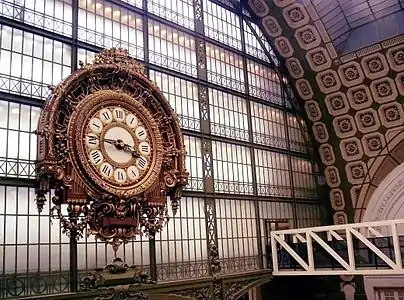

The museum building was originally a railway station, Gare d'Orsay, located next to the Seine river. Built on the site of the Palais d'Orsay, its central location was convenient for commuting travelers.[5] The station was constructed for the Chemin de Fer de Paris à Orléans and finished in time for the 1900 Exposition Universelle to the design of three architects: Lucien Magne, Émile Bénard and Victor Laloux. The Gare d'Orsay design was considered to be an "anachronism."[6] Since trains were such a modern innovation for the time architects and designers alike expected a building that would embody the modern traits of this new mode of transportation. Gare d'Orsay instead gained inspiration from the past for the concept of the facade to the point of masking the cutting-edge technology within. It was the terminus for the railways of southwestern France until 1939.
By 1939 the station's short platforms had become unsuitable for the longer trains that had come to be used for mainline services. After 1939 it was used for suburban services and part of it became a mailing centre during World War II. It was then used as a set for several films, such as Kafka's The Trial adapted by Orson Welles, and as a haven for the Renaud–Barrault Theatre Company and for auctioneers, while the Hôtel Drouot was being rebuilt.
In the 1970s work began on building a 1 km-long tunnel under the station as part of the creation of line C of the Réseau Express Régional with a new station under the old station. In 1970, permission was granted to demolish the station but Jacques Duhamel, Minister for Cultural Affairs, ruled against plans to build a new hotel in its stead. The station was put on the supplementary list of Historic Monuments and finally listed in 1978. The suggestion to turn the station into a museum came from the Directorate of the Museum of France. The idea was to build a museum that would bridge the gap between the Louvre and the National Museum of Modern Art at the Georges Pompidou Centre. The plan was accepted by Georges Pompidou and a study was commissioned in 1974. In 1978, a competition was organized to design the new museum. ACT Architecture, a team of three young architects (Pierre Colboc, Renaud Bardon and Jean-Paul Philippon), were awarded the contract which involved creating 20,000 square metres (220,000 sq ft) of new floorspace on four floors. The construction work was carried out by Bouygues.[7] In 1981, the Italian architect Gae Aulenti was chosen to design the interior including the internal arrangement, decoration, furniture and fittings of the museum. The arrangement of the galleries she designed was elaborate and inhabited the three main levels that are under the museum's barrel vault atrium. On the main level of the building, a central nave was formed by the surrounding stone structures that were previously the building's train platforms. The central nave's structures break up the immense sculpture and gallery spaces and provided more organized units for viewing the art.[8] In July 1986, the museum was ready to receive its exhibits. It took 6 months to install the 2000 or so paintings, 600 sculptures and other works. The museum officially opened in December 1986 by then-president François Mitterrand.
At any time about 3,000 art pieces are on display within Musée d'Orsay. Within the museum is a 1:100 scale model created by Richard Peduzzi of an aerial view of Paris Opera and surrounding area encapsulated underneath glass flooring that viewers walk on as they proceed through the museum. This installation allows the viewers to understand the city planning of Paris at the time, which has made this attraction one of the most popular within the museum.
Another exhibit within the museum is "A Passion for France: The Marlene and Spencer Hays Collection". This collection was donated by an Marlene and Spencer Hays, art collectors who reside in Texas and have been collecting art since the early 1970s. In 2016 the museum complied to keeping the collection of about 600 art pieces in one collection rather than dispersed throughout other exhibits. Since World War II, France has not been donated a collection of foreign art this large. The collection favors mostly post-impressionist works. Artists featured in this collection are Bonnard, Vuillard, Maurice Denis, Odilon Redon, Aristide Maillol, André Derain, Edgar Degas, and Jean-Baptiste-Camille Corot.[9] To make room for the art that has been donated, the Musée d'Orsay is scheduled to undergo a radical transformation over the next decade, 2020 on. This remodel is funded in part by an anonymous US patron who donated €20 million to a building project known as Orsay Grand Ouvert (Orsay Wide Open). The gift was made via the American Friends of the Musées d'Orsay et de l'Orangerie.[10] The projected completion date is 2026, implementing new galleries and education opportunities to endorse a conductive experience.[11]
The square next to the museum displays six bronze allegorical sculptural groups in a row, originally produced for the Exposition Universelle:
- South America by Aimé Millet
- Asia by Alexandre Falguière
- Oceania by Mathurin Moreau
- Europe by Alexandre Schoenewerk
- North America by Ernest-Eugène Hiolle
- Africa by Eugène Delaplanche
Collection
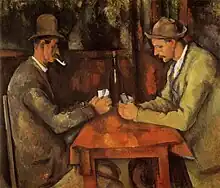


Paintings: major painters and works represented
- Frédéric Bazille – 6 paintings including The Family Reunion, The Improvised Field Hospital, The Pink Dress, Studio in Rue de La Condamine
- Cecilia Beaux – Sita and Sarita (Jeune Fille au Chat)
- Rosa Bonheur - Ploughing in the Nivernais
- Pierre Bonnard – 60 paintings including The Chequered Blouse
- Eugène Boudin – 33 paintings including Trouville Beach
- William-Adolphe Bouguereau – 12 paintings including The Birth of Venus, La Danse, Dante and Virgil
- Louise Catherine Breslau - 4 paintings including Portrait of Henry Davison
- Alexandre Cabanel – The Birth of Venus, The Death of Francesca da Rimini and Paolo Malatesta
- Gustave Caillebotte – 7 paintings including The Floor Scrapers, Vue de toits (Effet de neige)
- Eugène Carrière – 86 paintings including The Painting Family, The Sick Child, Intimacy
- Mary Cassatt – 1 painting
- Paul Cézanne – 56 paintings including Apples and Oranges, The Hanged Man's House, The Card Players, Portrait of Gustave Geffroy
- Théodore Chassériau – 5 paintings (the main collection of his paintings is in the Louvre)
- Pierre Puvis de Chavannes – Young Girls by the Seaside, The Young Mother also known as Charity, View on the Château de Versailles and the Orangerie
- Gustave Courbet – 48 paintings including The Artist's Studio, A Burial at Ornans, Young Man Sitting, L'Origine du monde, Le ruisseau noir, Still-Life with Fruit, The Wave, The Wounded Man
- Jean-Baptiste-Camille Corot – 32 paintings (the main collection of his paintings is in the Louvre) including A Morning. The Dance of the Nymphs
- Henri-Edmond Cross – 10 paintings including The Cypresses in Cagnes
- Leon Dabo – 1 paintings Moore Park
- Henri-Camille Danger - Fleau!
- Charles-François Daubigny - The Harvest
- Honoré Daumier – 8 paintings including The Laundress
- Edgar Degas – 43 works including paintings such as The Parade, also known as Race Horses in front of the Tribunes, The Bellelli Family, The Tub, Portrait of Édouard Manet, Portraits, At the Stock Exchange, L'Absinthe, and pastels like Café-Concert at Les Ambassadeurs and Les Choristes
- Alfred Dehodencq - Boabdil's Farewell to Granada
- Eugène Delacroix – 5 paintings (the main collection of his paintings is in the Louvre)
- Maurice Denis – Portrait of the Artist Aged Eighteen, Princess Maleine's Minuet or Marthe Playing the Piano, The Green Trees or Beech Trees in Kerduel, October Night (panel for the decoration of a girl's room), Homage to Cézanne
- André Derain – Charing Cross Bridge, also known as Westminster Bridge
- Édouard Detaille – The Dream
- Albert Edelfelt - Pasteur's portrait by Edelfelt
- Henri Fantin-Latour - Around the Piano, A Studio at Les Batignolles
- Paul Gauguin – 24 paintings including Arearea, Tahitian Women on the Beach
- Jean-Léon Gérôme – Portrait of the Baroness Nathaniel de Rothschild, Reception of Condé in Versailles, La Comtesse de Keller, The Cock Fight, Jerusalem
- Vincent van Gogh – 24 paintings including L'Arlésienne, Bedroom in Arles, Self Portrait, portrait of his friend Eugène Boch, The Siesta, The Church at Auvers, View from the Chevet, The Italian Woman, Starry Night, Portrait of Dr. Gachet, Doctor Gachet's Garden in Auvers, Imperial Fritillaries in a Copper Vase, Saint-Paul Asylum, Saint-Rémy, Self Portrait
- Armand Guillaumin – 44 paintings
- Ferdinand Hodler – Der Holzfäller (The Woodcutter)
- Jean Auguste Dominique Ingres – 4 paintings (the main collection of his paintings is in the Louvre) including The Source
- Eugène Jansson – Proletarian Lodgings
- Johan Barthold Jongkind – 9 paintings
- Gustav Klimt – 1 painting
- Maximilien Luce - The Quai Saint-Michel and Notre-Dame
- Édouard Manet – 34 paintings including Olympia, The Balcony, Berthe Morisot With a Bouquet of Violets, The Luncheon on the Grass, The Fifer, The Reading
- Henri Matisse - Luxe, Calme et Volupté
- Gustave Doré - Master of Imagination collection
- Jean-François Millet – 27 paintings including The Angelus, Spring, The Gleaners
- Piet Mondrian – 2 paintings
- Claude Monet – 86 paintings (another main collection of his paintings is in the Musée Marmottan Monet) including The Saint-Lazare Station, The Rue Montorgueil in Paris. Celebration of 30 June 1878, Wind Effect, Series of The Poplars, Rouen Cathedral. Harmony in Blue, Blue Water Lilies, Le Déjeuner sur l'herbe, Haystacks, The Magpie, Women in the Garden
- Gustave Moreau – 8 paintings including L'Apparition
- Berthe Morisot – 9 paintings
- Henri-Paul Motte - The Fiancée of Belus
- Edvard Munch – 1 painting
- Henri Ottmann - The Luxembourg Station in Brussels
- Camille Pissarro – 46 paintings including White Frost
- Odilon Redon – 106 paintings including Caliban
- Henri Regnault - Summary Execution under the Moorish Kings of Granada
- Pierre-Auguste Renoir – 81 paintings including Bal au moulin de la Galette, Montmartre, The Bathers, Dance in the City, Dance in the Country, Frédéric Bazille at his Easel, Girls at the Piano, The Swing
- Henri Rousseau – 3 paintings
- Théo van Rysselberghe – 6 paintings
- Paul Sérusier – The Talisman, the Aven River at the Bois d'Amour
- Georges Seurat – 19 paintings including The Circus
- Paul Signac – 16 paintings including Women at the Well
- Alfred Sisley – 46 paintings including Inondation at Port-Marly
- Henri de Toulouse-Lautrec – 18 paintings including La Toilette
- Félix Vallotton – Misia at Her Dressing Table
- Édouard Vuillard – 70 paintings
- James McNeill Whistler – 3 paintings including Arrangement in Grey and Black: The Artist's Mother, also known as Whistler's Mother
.jpg.webp) Ernest Barrias, Nature Unveiling Herself, 1899
Ernest Barrias, Nature Unveiling Herself, 1899
Sculptures
Sculpture was in high demand in the 19th century and became widely used as a way to display a person's social and political standings. The style and ideology represented by many of the sculptures were out of fashion by the mid-20th century, and the sculptures were put into storage and no longer displayed. It wasn't until the conversion of the Orsay railway station into the Musée d'Orsay museum in the 1970s that many sculptures from the 19th century were placed on exhibit again. The substantial nave inside the new museum offered a perfect area for the display of sculptures. During the grand opening in December 1986 of the museum, 1,200 sculptures were present, brought in from collections such as the Louvre, state loans, and Musée du Luxembourg. The museum also obtained more than 200 sculptures before opening though donations of art connoisseurs, the lineage of artists, and people in support of the Musée d'Orsay.[12]
Since the grand opening in 1986 the museum has collected works from exchanges that other museums or institutions once showcased such as Nature Unveiling Herself Before Science by Louis-Ernest Barrias that was initially commissioned for Conservatoire des Arts et Métiers, as well as The Thinker and The Gates of Hell by Auguste Rodin. The museum also purchases specific works to fill gaps and finish the collections already in the museum such as one of the panels of Be Mysterious by Paul Gauguin, the full set of Honoré Daumier's Célébrités du Juste Milieu, and Maturity by Camille Claudel. There are currently more than 2,200 sculptures in the Musée d'Orsay.[12]
Major sculptors represented in the collection include Alfred Barye, François Rude, Jules Cavelier, Jean-Baptiste Carpeaux, Émile-Coriolan Guillemin, Auguste Rodin, Paul Gauguin, Camille Claudel, Sarah Bernhardt, Aristide Maillol and Honoré Daumier.
Other works
It also holds collections of:
- architecture and decorative arts
- photography
Selected collection highlights
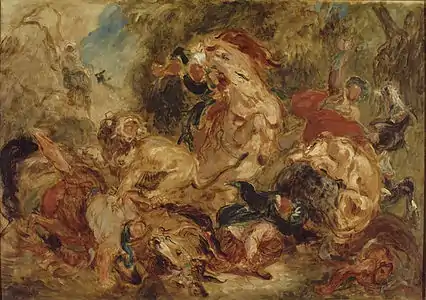 Eugène Delacroix, The Lion Hunt, c. 1854
Eugène Delacroix, The Lion Hunt, c. 1854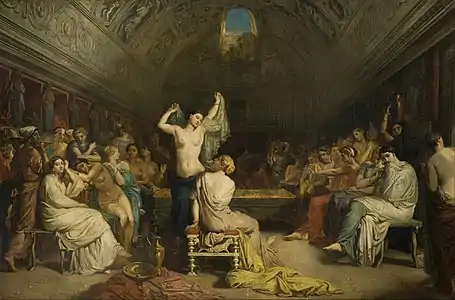 Théodore Chassériau, Tepidarium, 1853
Théodore Chassériau, Tepidarium, 1853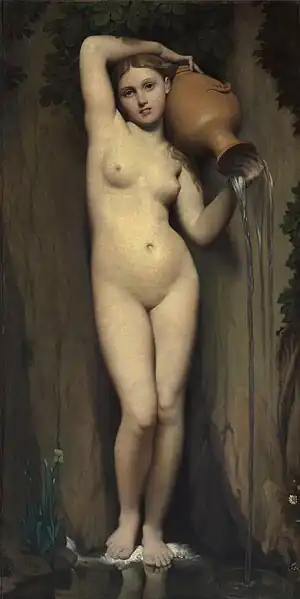
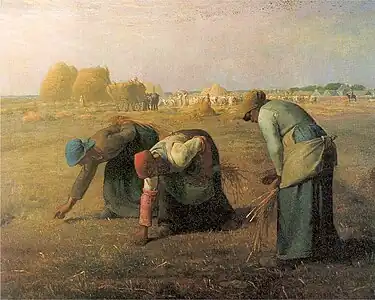 Jean-François Millet, The Gleaners, 1857
Jean-François Millet, The Gleaners, 1857 Édouard Manet, Olympia, 1863
Édouard Manet, Olympia, 1863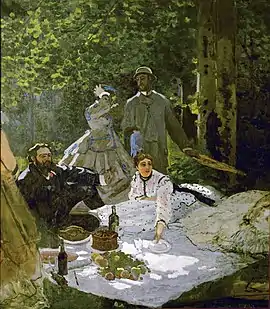
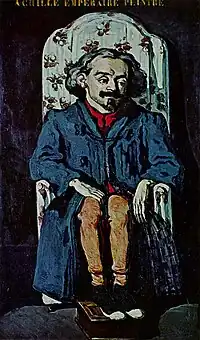 Paul Cézanne, Portrait of Achille Emperaire, 1868
Paul Cézanne, Portrait of Achille Emperaire, 1868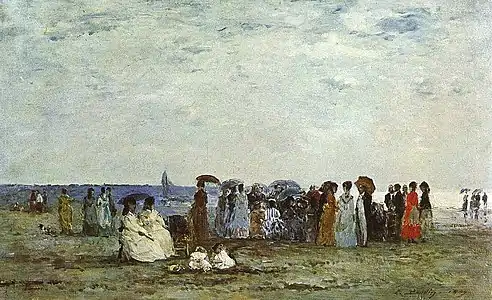 Eugène Boudin, Bathers on the Beach at Trouville, 1869
Eugène Boudin, Bathers on the Beach at Trouville, 1869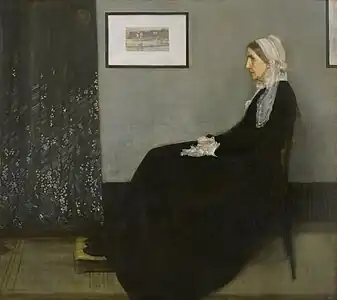
 Gustave Caillebotte, Les raboteurs de parquet (The Floor Scrapers), 1875
Gustave Caillebotte, Les raboteurs de parquet (The Floor Scrapers), 1875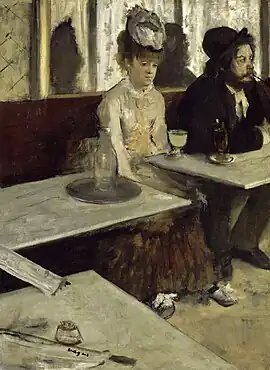 Edgar Degas, L'Absinthe, 1876
Edgar Degas, L'Absinthe, 1876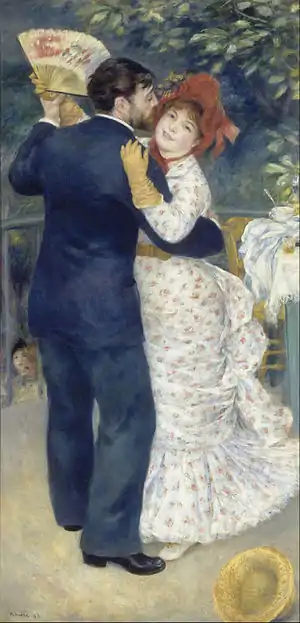
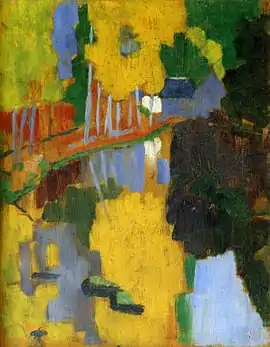
 Self-portrait (1889) by Vincent van Gogh
Self-portrait (1889) by Vincent van Gogh
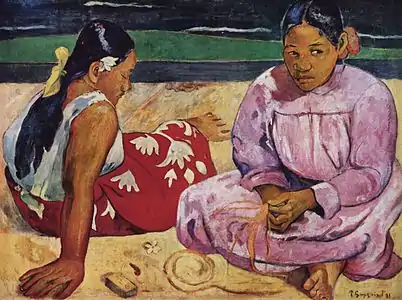
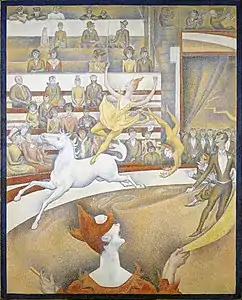 Georges Seurat, The Circus, 1891
Georges Seurat, The Circus, 1891%252C_partially_glazed_stoneware%252C_75_x_19_x_27_cm%252C_Mus%C3%A9e_d'Orsay%252C_Paris.jpg.webp) Paul Gauguin, Oviri (Sauvage), 1894
Paul Gauguin, Oviri (Sauvage), 1894%252C_68.5_x_141.5_x_6_cm%252C_Mus%C3%A9e_d'Orsay%252C_Paris._DSC09000.jpg.webp) Georges Lacombe, L'Existence, 1894–1896
Georges Lacombe, L'Existence, 1894–1896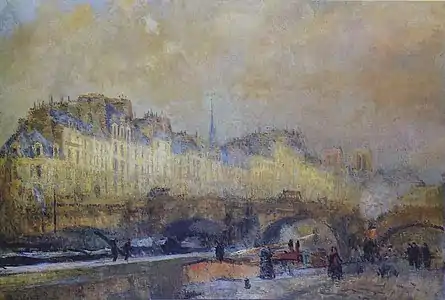 Albert Lebourg, Paris, l'écluse de la Monnaie. Soleil d'hiver
Albert Lebourg, Paris, l'écluse de la Monnaie. Soleil d'hiver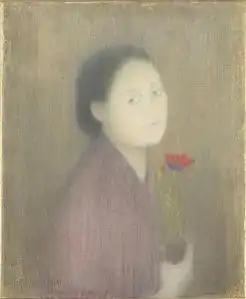 József Rippl-Rónai, Female with Flower, 1891
József Rippl-Rónai, Female with Flower, 1891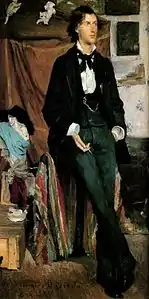 Louise Catherine Breslau, Portrait of Henry Davison, 1880
Louise Catherine Breslau, Portrait of Henry Davison, 1880 Joaquín Sorolla, La Vuelta de la Pesca, 1894
Joaquín Sorolla, La Vuelta de la Pesca, 1894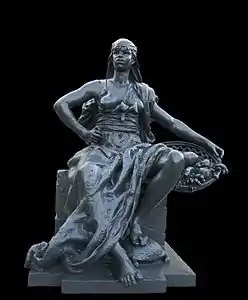 Eugène Delaplanche, Africa, 1878
Eugène Delaplanche, Africa, 1878
Management
The Directors have been:
- Françoise Cachin: 1986 – 1994
- Henri Loyrette: 1994 – 2001
- Serge Lemoine: 2001 – 2008
- Guy Cogeval: March 2008 – March 2017
- Laurence des Cars: March 2017 – present
References
- "Musée d'Orsay: About". ArtInfo. 2008. Archived from the original on 22 October 2008. Retrieved 30 July 2008.
- "The Art Newspaper". 5 January 2023.
- "The Art Newspaper", March 27, 2023
- Franceinfo Culture, 5 January 2023
- "Musee d'Orsay | History, Art, & Facts". Encyclopedia Britannica. Retrieved 14 March 2021.
- Mainardi, Patricia (1987). "Postmodern History at the Musée d'Orsay". October. 41: 31–52. doi:10.2307/778328. ISSN 0162-2870. JSTOR 778328.
- "Bouygues website: Musée d'Orsay". Bouygues.com. Archived from the original on 5 December 2008. Retrieved 20 June 2012.
- "Musée d'Orsay". Britannica Academic. Retrieved 16 March 2021.
- "Login". weblogin.asu.edu. Retrieved 8 March 2021.
- Gareth Harris (March 6, 2020), Anonymous €20m donation kickstarts Musée d'Orsay transformation The Art Newspaper.
- Pogrebin, Robin (5 March 2020). "Musée d'Orsay to Expand Spaces for Exhibitions and Education (Published 2020)". The New York Times. ISSN 0362-4331. Retrieved 8 March 2021.
- "Musée d'Orsay: Sculpture". www.musee-orsay.fr. Retrieved 17 March 2021.


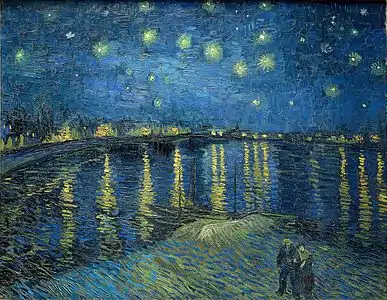




.jpg.webp)